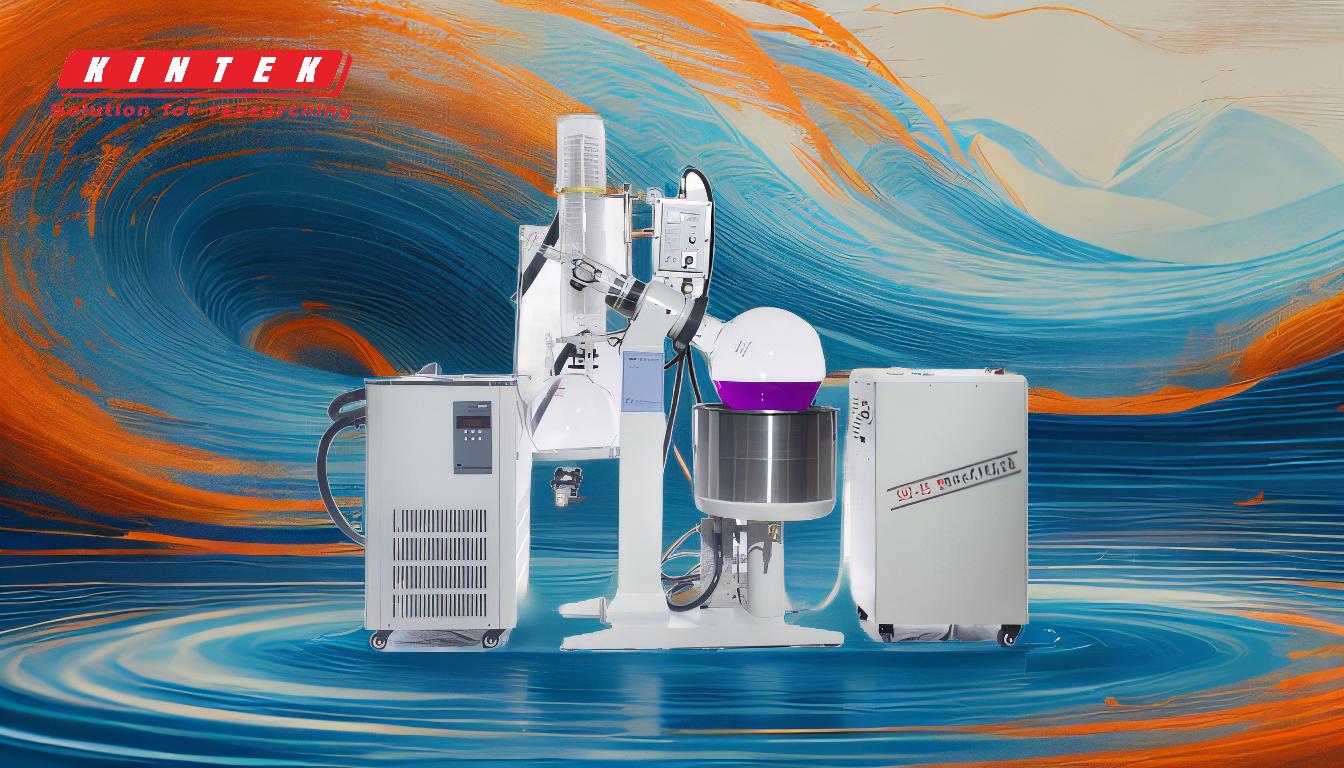A rotary evaporator, or rotavap, is a device used in laboratories to efficiently and gently remove solvents from samples through evaporation. It operates under reduced pressure (vacuum) to lower the boiling point of the solvent, allowing it to evaporate at lower temperatures, which is particularly useful for heat-sensitive materials. The process involves rotating the sample flask to create a thin film of the solution on the inner wall, increasing the surface area for evaporation. The solvent vapor is then condensed and collected in a separate flask, leaving behind a concentrated solution. This method is widely used in chemistry, pharmaceuticals, and food science for solvent recovery and sample concentration.
Key Points Explained:

-
Principle of Operation:
- Vacuum Distillation: The rotary evaporator works on the principle of vacuum distillation. By reducing the pressure inside the system, the boiling point of the solvent is lowered, allowing it to evaporate at a much lower temperature than at atmospheric pressure. This is particularly beneficial for heat-sensitive compounds that could degrade at higher temperatures.
- Rotation of the Flask: The evaporation flask is rotated at a constant speed, which creates a thin, uniform film of the sample on the inner wall of the flask. This increases the surface area available for evaporation, speeding up the process and ensuring even heating.
-
Components and Their Functions:
- Evaporation Flask: This is where the sample is placed. The flask is rotated to create a thin film of the sample, enhancing evaporation.
- Water or Oil Bath: The flask is partially immersed in a temperature-controlled bath (water or oil) to provide uniform heating. The temperature is set based on the solvent's boiling point under reduced pressure.
- Vacuum Pump: The vacuum pump reduces the pressure inside the system, lowering the boiling point of the solvent.
- Condenser: The solvent vapor is cooled and condensed back into liquid form by a condenser, usually cooled by circulating water. The condensed solvent is collected in a separate flask.
- Receiving Flask: This is where the condensed solvent is collected after passing through the condenser.
-
Process Steps:
- Setup: The sample is placed in the evaporation flask, which is then attached to the rotary evaporator. The water or oil bath is turned on and set to the desired temperature.
- Vacuum Application: The vacuum pump is turned on, and the system is placed under reduced pressure. This lowers the boiling point of the solvent.
- Rotation: The flask is rotated at a constant speed, creating a thin film of the sample on the inner wall, which increases the surface area for evaporation.
- Evaporation: The solvent evaporates from the thin film, and the vapor is carried to the condenser.
- Condensation: The solvent vapor is cooled in the condenser and collected in the receiving flask.
- Completion: Once the solvent has been completely removed, the flask is raised out of the bath, rotation is stopped, and the vacuum is released. The concentrated sample remains in the evaporation flask.
-
Advantages:
- Gentle Evaporation: The reduced pressure allows for gentle evaporation, which is crucial for heat-sensitive materials.
- Efficiency: The rotation of the flask and the increased surface area make the process faster and more efficient than traditional evaporation methods.
- Solvent Recovery: The condensed solvent can be collected and reused, making the process more economical and environmentally friendly.
-
Applications:
- Chemistry: Used for concentrating reaction mixtures, purifying compounds, and recovering solvents.
- Pharmaceuticals: Essential for drug development and purification processes.
- Food Science: Used in the extraction of flavors, fragrances, and other compounds from food samples.
-
Considerations for Equipment Purchase:
- Vacuum Level: Ensure the rotary evaporator can achieve the necessary vacuum level for the solvents you work with.
- Temperature Control: Look for precise temperature control in the heating bath to handle a wide range of solvents.
- Flask Size: Choose a model that accommodates the volume of samples you typically work with.
- Condenser Efficiency: A high-efficiency condenser will improve solvent recovery and overall process efficiency.
- Safety Features: Consider models with safety features such as automatic lift mechanisms and pressure release valves.
By understanding these key points, a purchaser can make an informed decision when selecting a rotary evaporator, ensuring it meets their specific needs for solvent concentration and recovery.
Summary Table:
| Key Aspect | Details |
|---|---|
| Principle of Operation | Vacuum distillation lowers boiling points; rotation increases surface area. |
| Main Components | Evaporation flask, water/oil bath, vacuum pump, condenser, receiving flask. |
| Process Steps | Setup, vacuum application, rotation, evaporation, condensation, completion. |
| Advantages | Gentle evaporation, high efficiency, solvent recovery, and eco-friendliness. |
| Applications | Chemistry, pharmaceuticals, food science for solvent recovery and concentration. |
| Purchase Considerations | Vacuum level, temperature control, flask size, condenser efficiency, safety features. |
Ready to enhance your lab's efficiency? Contact us today to find the perfect rotary evaporator for your needs!










